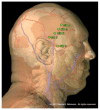One Medicine, One Acupuncture
- PMID: 26487029
- PMCID: PMC4494296
- DOI: 10.3390/ani2030395
One Medicine, One Acupuncture
Abstract
"One Acupuncture", like "One Medicine", has the potential to improve research quality and clinical outcomes. However, while human acupuncture point locations have remained largely consistent over time, the veterinary versions remain imprecise and variable. Establishing anatomical criteria for veterinary acupuncture atlases in keeping with the human template will create congruence across species, benefiting both research and practice. Anatomic criteria for points based on objectively verifiable structures will facilitate translational research. Functionally comparative innervation, in particular, should be similar between species, as the nerves initiate and mediate physiologic changes that result from point stimulation. If researchers choose points that activate different nerves in one species than in another, unpredictable outcomes may occur. Variability in point placement will impede progress and hamper the ability of researchers and clinicians to make meaningful comparisons across species. This paper reveals incongruities that remain between human and veterinary acupuncture points, illustrating the need to analyze anatomical characteristics of each point to assure accuracy in selecting transpositional acupuncture locations.
Keywords: One Acupuncture; One Medicine; acupuncture; anatomy; comparative anatomy; neuromodulation; translational research; veterinary acupuncture.
Figures






Similar articles
-
Proposed catalog of the neuroanatomy and the stratified anatomy for the 361 acupuncture points of 14 channels.J Acupunct Meridian Stud. 2013 Oct;6(5):270-4. doi: 10.1016/j.jams.2013.01.001. Epub 2013 Feb 7. J Acupunct Meridian Stud. 2013. PMID: 24139465
-
Acupuncture Points of the Horse's Distal Thoracic Limb: A Neuroanatomic Approach to the Transposition of Traditional Points.Animals (Basel). 2012 Sep 17;2(3):455-71. doi: 10.3390/ani2030455. Animals (Basel). 2012. PMID: 26487033 Free PMC article.
-
Comparison of Point Placement by Veterinary Professionals with Different Levels of Acupuncture Training in a Canine Cadaver Model.J Acupunct Meridian Stud. 2017 Oct;10(5):360-370. doi: 10.1016/j.jams.2017.08.002. Epub 2017 Aug 12. J Acupunct Meridian Stud. 2017. PMID: 29078972
-
[Our Considerations About Studies on Structure of Acupuncture Points].Zhen Ci Yan Jiu. 2018 May 25;43(5):285-9. doi: 10.13702/j.1000-0607.170911. Zhen Ci Yan Jiu. 2018. PMID: 29888561 Review. Chinese.
-
Veterinary Neurologic Rehabilitation: The Rationale for a Comprehensive Approach.Top Companion Anim Med. 2018 Jun;33(2):49-57. doi: 10.1053/j.tcam.2018.04.002. Epub 2018 May 16. Top Companion Anim Med. 2018. PMID: 30236409 Review.
Cited by
-
Veterinary acutherapy in management of musculoskeletal disorders: An eye-opener to the developing countries' veterinarians.Open Vet J. 2020 Oct;10(3):252-260. doi: 10.4314/ovj.v10i3.2. Epub 2020 Jul 29. Open Vet J. 2020. PMID: 33282695 Free PMC article. Review.
-
Spotlight on acupuncture in laboratory animal medicine.Vet Med (Auckl). 2017 Aug 24;8:53-58. doi: 10.2147/VMRR.S125609. eCollection 2017. Vet Med (Auckl). 2017. PMID: 30050856 Free PMC article. Review.
-
Spatial topological analysis of sympathetic neurovascular characteristic of acupoints in Ren meridian using advanced tissue-clearing and near infrared II imaging.Comput Struct Biotechnol J. 2021 Apr 8;19:2236-2245. doi: 10.1016/j.csbj.2021.04.010. eCollection 2021. Comput Struct Biotechnol J. 2021. PMID: 33995916 Free PMC article.
-
Guidance for Acupuncture Robot with Potentially Utilizing Medical Robotic Technologies.Evid Based Complement Alternat Med. 2021 Mar 31;2021:8883598. doi: 10.1155/2021/8883598. eCollection 2021. Evid Based Complement Alternat Med. 2021. PMID: 33859714 Free PMC article. Review.
-
The Emperor's New Clothes-An Epistemological Critique of Traditional Chinese Veterinary Acupuncture.Animals (Basel). 2019 Apr 15;9(4):168. doi: 10.3390/ani9040168. Animals (Basel). 2019. PMID: 30991678 Free PMC article.
References
-
- King L.J., Anderson L.R., Blackmore C.G., Blackwell M.J., Lautner E.A., Marcus L.C., Meyer T.E., Monath T.P., Nave J.E., Ohle J., Pappaioanou M., Sobota J., Stokes W.S., Davis R.M., Glaser J.H., and Mahr R.K. Executive summary of the AVMA One Health Initiative Task Force report. J. Am. Vet. Med. Assoc. 2008;233:259–261. doi: 10.2460/javma.233.2.259. - DOI - PubMed
Publication types
LinkOut - more resources
Full Text Sources

